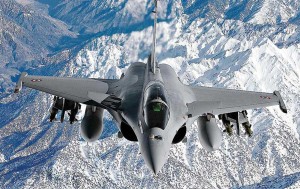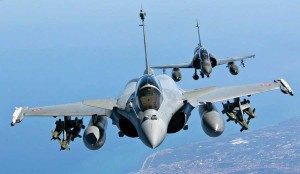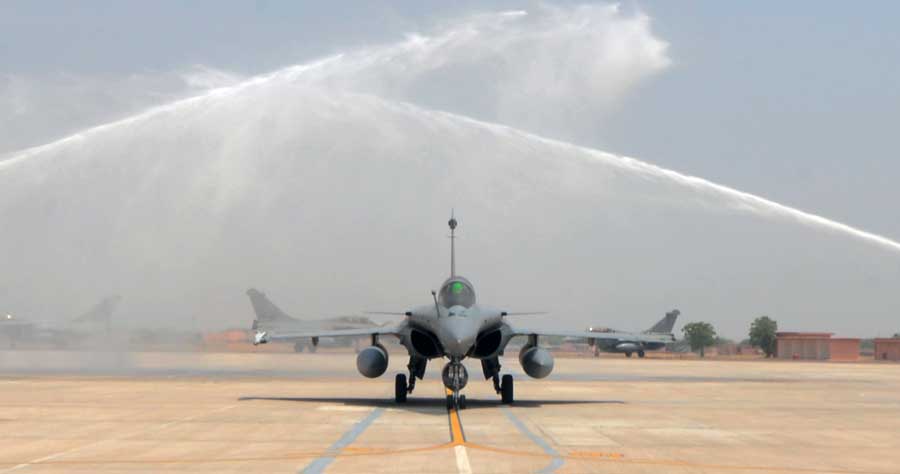Do you have a close relation with Air Chief Marshal Raha?
In fact, I met him today for the first time. He has taken over quite recently and we hadn’t yet had a chance to get acquainted. This is also the purpose of this quick visit. It was important for me to attend the Garuda exercise and to see my personnel, but I really wanted to meet my counterpart, to lay a first stone, which would allow us to meet again in future and to see how we can continue to improve together through Garuda. There should be more such exercises, hopefully soon.
It took 10 hours and 40 minutes to reach there and 10 hours and 50 minutes to fly back.
Would this take place in France?
Yes, this is what I will propose.
When would that be?
In two years’ time, I hope. Of course, there can be unforeseeable factors, but in my view, two years is definitely the right pace.
Some questions about France now. What did the French Air Force learn from its latest campaigns in Libya or in Mali?
In my view, the latest campaigns have demonstrated one thing: the first and foremost duty of an Air Force is to be responsive. We already possess this responsiveness through our two permanent missions. The first one is Air Defence, which requires us to react in a matter of minutes to ensure the sovereignty and protection of national airspace. The second is the Nuclear Deterrence mission, which also imposes stringent readiness constraints. It has to be assured according to a permanent alert posture decided by the President of the Republic.
Besides this, in the case of the first operations in Libya we were required to react within 24 hours. We were able to respond at such short notice thanks to our two permanent missions, whose execution implies constantly maintaining several air bases on alert, as well as information systems and command and control centres.
In the Mali operation, in order to stop the jihadists and to prevent them from regrouping and threatening the capital Bamako, we had to react in less than 48 hours. That is why we decided to strike directly from France, with a very long-range raid of almost ten hours of flight and more than 20 targets to strike. We had to do it.
 We have also been close to performing other missions at other theatres of operation, each time at very short notice, within just a few hours. When we were asked to provide reassurance by participating in the air policing of the Baltic States, we also responded very quickly.
We have also been close to performing other missions at other theatres of operation, each time at very short notice, within just a few hours. When we were asked to provide reassurance by participating in the air policing of the Baltic States, we also responded very quickly.
These operations have taught me one important lesson: I am now looking at ways to continue organising our Air Force so that, in addition to our two permanent missions, we possess this capability for immediate response from our national territory. Because the new capabilities we have today, the tactical and strategic airlift as well as our combat capability, now provide us with the required degree of responsiveness at very long range.
An Air Force with hundreds of aircraft needs capabilities for planning and control, and this will hold true even more in the future.
That is why, during a recent exercise, I wanted the Rafale to be deployed directly from the French mainland to the French Island of La Réunion, over 8,000 km away in the Southern Indian Ocean.
How long was that flight?
It took 10 hours and 40 minutes to reach there and 10 hours and 50 minutes to fly back.
Did you break a record?
Yes, we did. It was not just a long ferry flight; we also performed a simulated strike on the way. I wanted to demonstrate our ability to do this already now. We have also demonstrated our ability to ferry a Fennec helicopter with the new Airbus A400M military transport aircraft to French Guyana (South America) in record time. The A400M has also flown to Djibouti in the Horn of Africa and to Mali in the Sahel-Sahara region of Africa. The one key to all of this is the reorganisation of our air bases so that they can maintain their level of responsiveness, not only for the Air Defence and Nuclear Deterrence missions, but also for Strategic Projection abroad.
In the backdrop of on-going joint (tri-service) reforms, this requires us to reconsider a number of things, in some cases reverting to past concepts, such as actually operating from our air bases to launch air strikes, albeit thousands of kilometres away. The other key element that I wished to demonstrate, and recent operations have proved us right – which is always better – is the Command and Control Centre. Based in Lyon, it controls Air Defence missions over the French homeland, as well as all the operations we are currently conducting in Africa. All missions, whether in France or abroad, are now controlled from Lyon. The planning and control, no matter where the operation is in the world, is undertaken from Lyon in real time. This gives us an unequalled level of responsiveness, which no one else possesses in Europe, and, indeed, elsewhere – apart from the United States.
 I really wanted to demonstrate this, and we have succeeded much faster than expected, which gives me great satisfaction. Because this centre is manned for Air Defence, I can ring up tomorrow, or in an hour’s time, and I’m sure to find people there at any time. I can tell them “I want this mission planned” and, whilst carrying on with Air Defence, they will plan a mission thousands of kilometres away. They are able to do this with competent people, who are on the watch round the clock.
I really wanted to demonstrate this, and we have succeeded much faster than expected, which gives me great satisfaction. Because this centre is manned for Air Defence, I can ring up tomorrow, or in an hour’s time, and I’m sure to find people there at any time. I can tell them “I want this mission planned” and, whilst carrying on with Air Defence, they will plan a mission thousands of kilometres away. They are able to do this with competent people, who are on the watch round the clock.
Can it be an example for India?
An example, I don’t know, you should ask the Indian Air Force. But when I mentioned this concept they seemed interested, because only very few countries have achieved such a capability. I believe our concept can be of interest to others. I’ve offered the Indian Air Force to come and see for themselves what we’re doing in Lyon.
The Indian Air Force has this required mastery of networks and of managing complex missions, India is therefore absolutely capable of doing the same…
Is it a domain where there could be some collaboration?
Yes, I think so. An Air Force with hundreds of aircraft needs capabilities for planning and control, and this will hold true even more in the future.
We have built up such capability over the last two years. I am very satisfied. In Lyon, in one control room, you have people executing Air Defence 24/7 under the direct authority of the Prime Minister, on the other side of wall, we have the Air Component Command operating under the authority of the Joint Command Post based in N’Djamena, in Chad, and in the room next door, you have a unit which is coordinating intra-theatre Air Transport throughout Africa, operating under the authority of an EU mission whose Operational HQ is based in Greece. It is the same, single set of people who are doing all this, which provides a high level of responsiveness and a great economy of officers. This is a model that we have built, which I like talking about, and I see that others are interested.
Does the use of drones, as you have done in Mali, interest the Indian side?
Yes, I have been asked about our use of drones and our perspectives about their use in the future. There are different types of drones. Those used by our Air Force are the Medium-Altitude Long-Endurance (MALE) type, which can be sent thousands of kilometres away, which can fly 24 hours or more, which are remotely operated through satellites and whose images and data we can receive via satellite. These drones are of interest to Air Forces, as they provide a global and permanent vision of a theatre. But using such drones is complex, it requires mastering the networks. The Indian Air Force has this required mastery of networks and of managing complex missions, India is therefore absolutely capable of doing the same (while other Air Forces would find it more problematic). This is why, although there are still only few MALE drones today, I believe we will see more and more of this type in the future. But being able to operate this type of drone requires a comprehensive mastery of air operations, including the satellite segment. In other words, a certain maturity is needed.
Could you say something about the French White Paper on Defence and on the French multiyear spending law (Loi de Programmation Militaire)?
This White Paper was commissioned by the President of the French Republic after his election. It signals a rather important change, compared to the previous White Paper, with a different budgetary trajectory. All the Chiefs of Staff were involved in its drafting. We were all part of the White Paper Commission, we had a chance to put forward our own concerns. We are very much aware of the budgetary constraints that exist today and that weren’t there five years ago. We have endeavoured to achieve what President Hollande has outlined, but through new principles, which allow us to adjust our actions, particularly in terms of cost, while maintaining the same level of ambition and modernisation, so that we may continue improving in the future.
I personally believe in the qualities of the Rafale, and I would therefore be delighted to see this great Indian Air Force operating the same plane as we do.
This White Paper was translated into the Loi de Programmation Militaire. As far as I’m concerned, I am lucky to have an Air Force which possesses all the capabilities, which are extremely coherent. The choice I made was to maintain this coherence.
This requires a lot of effort, because we simultaneously have to reduce our personnel. We have built this model after accepting these constraints. More than accepting, I have asked the Air Force to embrace the changes unreservedly.
We recently had discussions on these perspectives after the Ministry of Finance asked for additional cuts. In that event, it would have been an altogether new strategy; it would have meant reopening the entire file, and building an altogether different project. It wasn’t possible to build the same project with less funds. It would not have been possible to follow the plan chalked out earlier.
This is what we explained to President Hollande, and a week ago, within the Defence Council, he reaffirmed that the Loi de Programmation Militaire and the level of ambition defined by the White Paper would be maintained. This had to be reaffirmed, so that we know where we are heading and so that we may continue in the direction charted out by the White Paper. As it often happens, we had a serious discussion with the Ministry of Finance, but I am glad that we can now continue on this path.
Which advice or which message would you like to give the Indian Air Force?
I have no advice to give to the Indian Air Force. They have a great Air Force. Two things I would like to tell them: first, we should try to enhance our mutual knowledge, to know each other’s perspectives better, and to develop our cooperation beyond the Garuda exercise and beyond the operational domain. Second and last, I personally believe in the qualities of the Rafale, and I would therefore be delighted to see this great Indian Air Force operating the same plane as we do.
Merci beaucoup, mon general!
Photo Courtesy: Minister of Defence, Government of France






the gentleman has written a number of factual articles which are pro indian but having gained credibility with indians he often advances the cause of France which is always not correct but natura las he is French– the aircraft might be good but not for the price they are asking
He is a French Airforce officer . So he will tell Rafale is the best. It is like Britishers will tell Roll Royce car is the best. General Motors will tell Cadillac car is the best. Ford Company will tell Lincoln cars is the best. It is all based on individual perception and nothing else. For me all are same. All the fighter plane are weapon carrying vehicles. None of the fighters can withstand multiple missiles attacks. Air superiority can achieve if we have better BVR missiles or ability to jam enemy radars. So this Air force officer is still imagining about the dog fight. F-16 fighter plane performed better in a dogfight with F-35. That does not mean F-35 is inferior. No one can say how the fighter planes will function in the rear war. The best example is Gnat. So all these analyse does not carry any meaning. For me,I give importance to weapons than vehicles. India should develop miniature rocket/missile.
Indians beware of this author. His sole agenda is to influence India’s threat perception in order to sell French products.
Your views are myopic. The author might be slightly biased but that goes for every author. However you are not justifying your comments with any data, which is making indian reply miserable. you are a porki in indian disguise
French made few mistakes. 1. they increase the price when it was not that much worth since they were thinking that they are the only one. 2. bad design, when people say that they can not copy their product with the instructions. it means they have written poor instructions. 3. in business prospective, business needs to be fair deal even there is no competitor. 4. because of above three, there will not even sell their aircraft to other nations unless they change their behavior.
Hey are you an astrologer
The great nation India is working very hard to ensure her national security and defense based on Russian and Western technology and equipment and had already arranged world largest top fifth ground, air and naval forces to survive and have to maintain global most complex and sensitive border with Pakistan and China. The honorable Indian Air Force is now operating 300 of Mig-21, hundreds of Mig-29 upgrading versions SU-30 and fifty home made Tejas LCA and recently going to buy Advanced technology based 120 French Raffle with technology transferring agreements with France and earnestly getting Mig-29k for her air craft carrier. In my mind, India should buy all of future air craft considering technology transfer based agreement to secure her future air defense and national air border. We generally may hope that India air force will be surely enriched with 300 of Tajas LCA home made replacing all of Mig-21 for light air combat, 200 of SU-30MKI, 240 Mig-29 upgrading France Raffle 200 ( including 80 of home made) within next five years. It is should be bear in mind that China has already decorated her air force with a great speed and recently launched home made stealth air craft J-20 and J-31 to strengthen air defense capabilities and also successful landing taste J-15 carrier based on the deck of Launing air craft carrier same as su-35 increasing power on the South and yellow sea of china. So, considering new challenging global military strategy India should apply own secret policy to enlarge air defense power over globally to make a new era as a responsible super power nation.